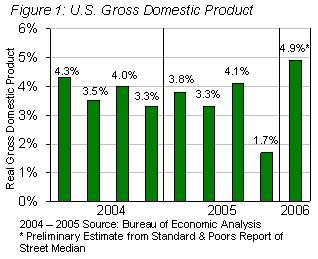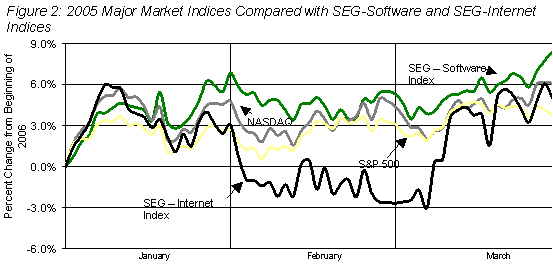|
|
| Home - Software M&A Review - May 06 Issue |
Software M&A – Q1 2006 was The Best Since '99 |
By Ken Bender and David Legacki, Software Equity Group, L.L.C.
Despite the relentless advance of crude oil prices, the Iraq quagmire, and concerns about a nuclear capable Iran, the US economy showed continued strength and noteworthy growth in the first quarter of 2006. Gross Domestic Product (GDP), a key economic indicator and broadest measure of economic activity, is projected to grow at a rate of 4.9% in 1Q06 versus the modest 1.7% recorded in 4Q05 (Figure 1). While this growth is encouraging, the specter of inflation continues to loom on the horizon.
 The consensus of economists surveyed by the Wall Street Journal is growth will slow to 3.3% in 2Q06 and will slow further during the remainder of the year. Goldman Sachs is projecting a 4.5% annual target for 2006. On the inflation front, energy prices are expected to take their toll. The Wall Street Journal's survey predicts the consumer price index will rise 3.2% in May and an additional 2.5% in November, up from 3.0% and 2.3% from their prior survey. The consensus of economists surveyed by the Wall Street Journal is growth will slow to 3.3% in 2Q06 and will slow further during the remainder of the year. Goldman Sachs is projecting a 4.5% annual target for 2006. On the inflation front, energy prices are expected to take their toll. The Wall Street Journal's survey predicts the consumer price index will rise 3.2% in May and an additional 2.5% in November, up from 3.0% and 2.3% from their prior survey.
The Conference Board's index of leading economic indicators, however, is less encouraging for the next two quarters. After rising by 0.4% in January, the index has fallen the last two months, down 0.5% in February and down another 0.1% in March. This key barometer signals slower growth through the balance of 2006. The price of oil and slowly rising interest rates are cited as catalysts for the decline. Five in ten indicators that comprise the leading index decreased in March. The positive contributors – beginning with the most positive contributor – were vendor performance, stock prices, index of consumer expectations, manufacturer's new orders for consumer goods and services, and interest rate spread. Negative contributors – beginning with the most negative – were building permits, average weekly initial claims for unemployment insurance (inverted), manufacturers" new orders for non-defense capital goods, and real money supply.
While this quarter marked the transition from long time Federal Reserve Chairman Alan Greenspan to newly appointed Fed Chair Ben Bernanke, the markets reacted positively, concluding that monetary policy will remain consistent. Over the quarter, the Fed continued to be proactively anti-inflation by raising the key Federal Funds rate 25 basis points to 4.5% at the end of January and another 25 basis points to 4.75% in March. The Fed has raised its benchmark interest rate 15 times since June 2004. Minutes from the March meeting indicate that Fed officials expect the economy to slow to a more sustainable pace after a strong first quarter. In spite of the recent rise in the Consumer Price Index, Fed Governors concluded that except for food and energy prices, the inflation rate was "not in the process of moving higher." The Wall Street Journal panel of economists project that the Fed Funds rate will rise to 5.0% in June and hold at that level through the balance of the year.
On the employment front, the Labor Department reported that employers added an impressive 211,000 non-farm jobs in March, only slightly fewer than the 225,000 jobs created in February. Over the past year, employers have added 2.1 million jobs, but the pace has increased to an average of 197,000 a month since December. The unemployment rate in March was down to 4.7% from 4.9% at the end of 2005 and while the average hourly wage for production workers rose at a lesser rate than the inflation rate over the past year, that trend is changing in 2006. The Wall Street Journal panel of economists projects stabilization at 4.7% unemployment for both their May and November targets.
Public Markets and Public Software & Internet Company Performance
After ending 2005 with modest gains of 3% and 1.4%, the S&P 500 and tech heavy NASDAQ picked up momentum in 1Q06, posting quarterly gains of 3.7% and 6.1%, respectively (Figure 2). That made 1Q06 the best first quarter for the S&P 500 since 1999 and the best first quarter for NASDAQ since 2000.

|
|


|

